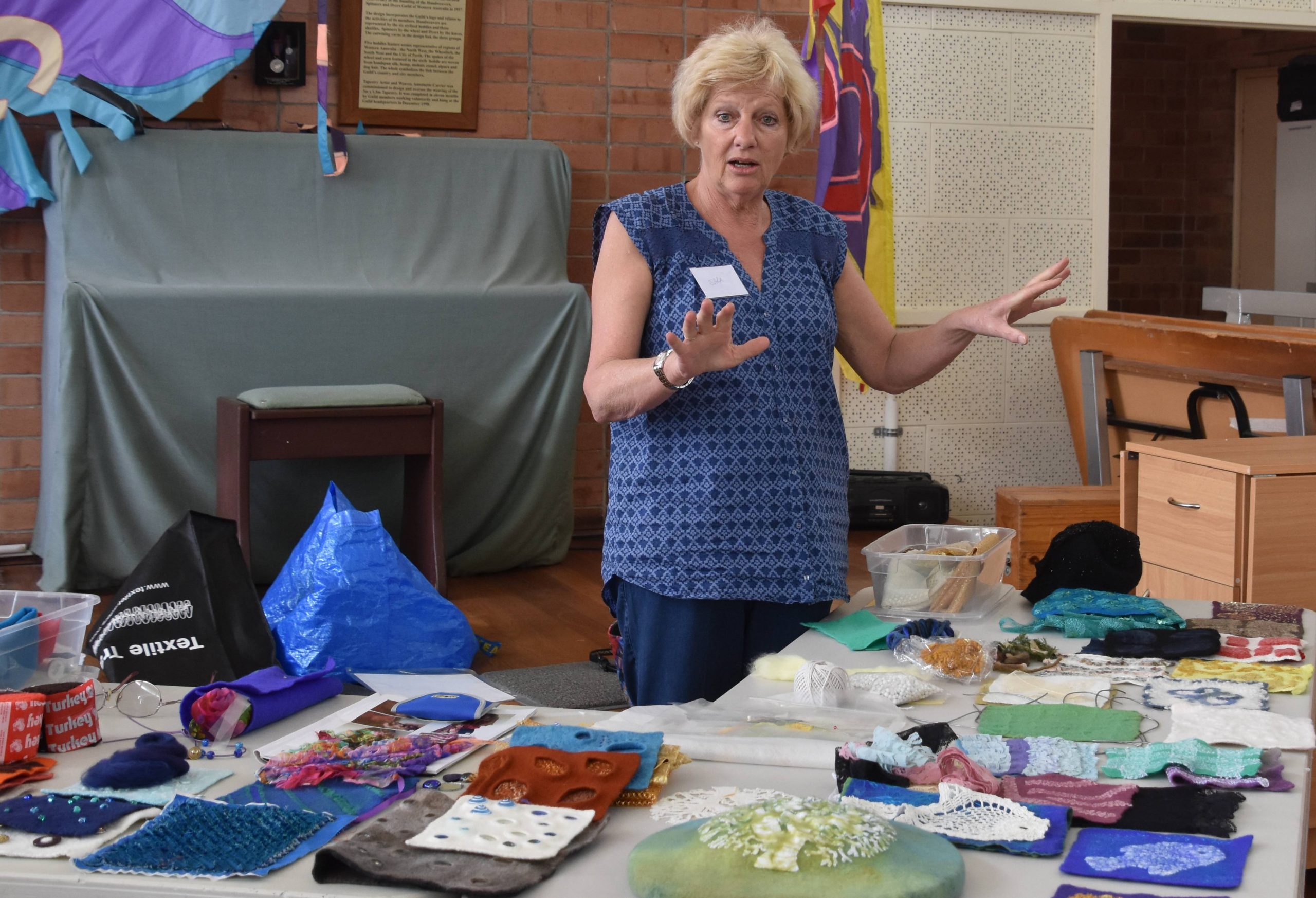
October 2017 Toss ‘n’ Tell
Demonstration – Surface Textures by Sara Quail 21 October 2017
Sara presented a fantastic and comprehensive demonstration, encompassing a huge variety of ideas & techniques that she has been experimenting with. I can hardly begin to represent it here…The accompanying pictures will help to tell the story.
Looking beyond conventional nuno felting with silk fabrics, Sara showed how other types of fabrics and fibres could be used to achieve surface texture. She had samples with beaded chiffon, sequinned, printed and embroidered synthetic organza, metallic mesh, hessian and recycled knitwear. As long as there are spaces through which the wool fibres can migrate, a range of synthetic yarns and even rug wool, can also be successfully felted. Wool yarns are more easily incorporated, while wool nepps don’t adhere well unless carded with a very small amount of wool fibre.
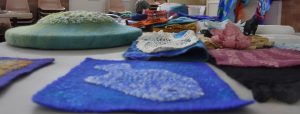
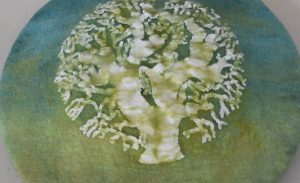
Because of their ‘holey’ structure, she has felted pieces of Cricula cocoon, skeleton leaves, crocheted items and nylon lace. Lace pieces can be laid out in lines, curves, grids or layered to create frills. Free machine embroidery worked on felt friendly fabric scraps, between 2 layers of water soluble fabric, creates another unusual effect with the stitching remaining on the surface. Generally, these items were laid out on dry wool fibre using gentle felting techniques until items are well attached.
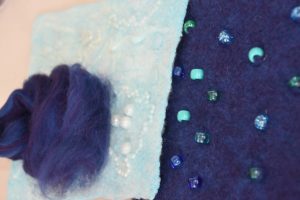
Raising the surface a little more, she demonstrated how medium sized beads and buttons with shanks can be in incorporated without stitching. A suitable needle is threaded with a thin piece of roving and passed through the hole. With about an inch of wool either side, this is then fluffed out and felted in with the wool base.
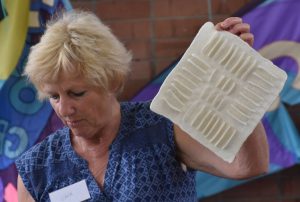
To create thin raised lines, nylon strings with their ends protruding can be placed between 2 wool layers, and removed once the piece is very well fulled and completely dry. Inclusions of found items like string, cords and polystyrene beads between wool layers create curvy lines and little lumps under the surface. She showed us how bigger items like shisha mirrors, glass beads, buttons and small objects can also be felted between layers of wool. Near the end of felting, the top layer can be cut to reveal about 2/3 of the encapsulated object.
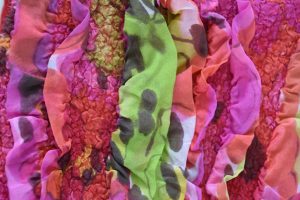
Sara then showed us how to create a crisp pleated effect by using thin plastic or tin foil on damp silk gauze or paj. Once the folds are created, wool fibre is placed on the fabric side and then carefully felted. The same method was used to produce a sample with multiple felted flaps. Instead of fabric, a prefelt was laid out on thin plastic, pleated, fibre placed on top and then felted. Many of her samples involve a lot more massaging at the beginning of the felting process because rolling too early is inclined to make things shift.
Using resists of narrow plastic strips or polyester ribbons, Sara revealed how a chenille effect could be achieved. The resist material is laid on the wool fibre and then covered with a lightweight fabric (silk gauze, paj or chiffon) and then felted. The fabric channels created are cut through to produce a chenille look. Varying widths of channels, type of fabric(s) and the amount of wool used will produce different results.
Expanding on th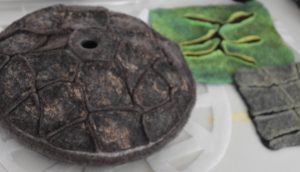 e ‘cracked earth’ technique where resist strips are laid between equal layers of wool and then cut, she showed how this principle can be used in other ways. Simple organic designs can be dramatic if contrasting colours are used and the cut edges are manipulated upwards. With additional cutting and manipulation near the end of the felting process, ‘doughnut’ shaped resists can become creative circular designs.
e ‘cracked earth’ technique where resist strips are laid between equal layers of wool and then cut, she showed how this principle can be used in other ways. Simple organic designs can be dramatic if contrasting colours are used and the cut edges are manipulated upwards. With additional cutting and manipulation near the end of the felting process, ‘doughnut’ shaped resists can become creative circular designs.

And lastly, Sara covered 3 distinctly different Shibori style techniques. This involves enclosing objects in a firm prefelt with either stitch or binding. Using very strong thread, more precise results can be achieved with stitching methods but are also more time consuming.
Toss ‘n’ Tell 21 October 2017
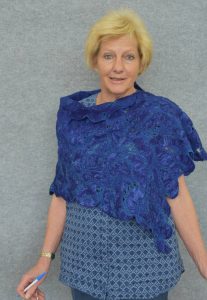
Sara Quail -asymmetric cape. Sara dyed this wrap a deep vibrant blue in both fibre active dye & acid dye in 2 stages, as it is made of wool, soy and cotton fibres, which respond to different types of dye. It was her first experiment with ‘deconstructed nuno’.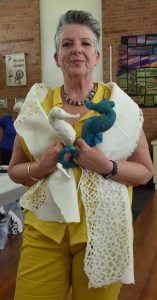
Jean McKenzie– made a beautiful white pine needle felted scarf/wrap at Leiko’s workshop. Also 2 felted seahorses as baby toys.

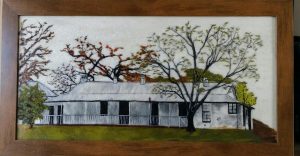
Mother and daughter felt team – A stunning needle felted picture of Tranby House in Maylands. Also displayed a blue, green, yellow pine needle felted scarf made at Leiko’s workshop and the needle felted cat “The Box Kitty”.
Stacey – a pine needle felted scarf produced at Leiko’s workshop. She also showed us a Felted Collar made via an online workshop with Fiona Duthie “Felting over the Edge”. (photo not shown).

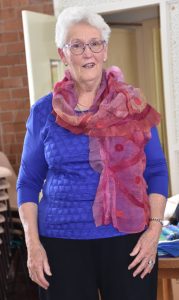 Pat – Nuno scarf in pink tones, very flattering.
Pat – Nuno scarf in pink tones, very flattering.
Judith – a shoulder bag with a face that she made many years ago. It provides her (and others) with a good source of amusement.
Toss ‘n’ Tell News 21 October 2017
Chair: Marion Finneron.
Craft House, Menora.
Reminders :
- The planning meeting is set for 28th October, which is to plan for 2018. The committee will look at suggestions noted in the suggestions book from members, among other things.
- Saturday 18 November will be the last meeting for the year, and will be our 21st Anniversary party. There will be a celebration lunch at Craft House with members & past members. Members were asked to contact any past members if they are able, many are not on email. Members were asked to bring a plate of food to share at the lunch party. Members were invited to bring a handmade wrapped gift for the ‘Kris Kringle’ if they wish to participate. There will also be the raffle draw from the $2 tickets that members pay each meeting. In order to win the prize, the winner must be present at the party on the day. The prize is a hamper of ‘felting goodies’.
- Craft House is open for felting in the morning from 9.30, as usual. Lunch will be at 12.00. There will be an informal Toss’n’Tell at lunchtime.
- Members were asked to return all outstanding library books by November 18. New books have been purchased for the library. Martien has donated a copy of the ‘Felt’ magazine that she edits to the library.
- She advised the members that we have a committee of 7 persons, where previously there had been 10. She called for members to approach the committee if they felt able to help with tasks. There is the possibility of forming subcommittees to help with projects etc.
- The meeting was advised that there are still places available at Martien’s upcoming ‘Jigsaw felt’ workshop.
- Marion introduced the committee to the members:
- Karen Wood has taken on the President’s role of Feltwest.
- Treasurer: Christiane Gray;
- Secretary: Marion Finneron;
- Workshop Co-ordinator: Sue Eslick;
- Online management: Liz Owens;
- Committee: Sara Quail;
- Committee: Alison Higgins
Questions raised:
Q: (Christiane) How do non-internet members find out about workshops etc?
A: A letter was mailed out earlier this year with part of the workshop program. It isn’t possible to do this for the whole year, as the workshop program is an evolving thing.
Q: Is it possible to mail hard copy of e-news out to non emailing members?
A: Suggestion from a member that each non-email member could be ‘adopted’ by an emailing member, who would undertake to send information on.
Q: (Jill Jodrell) Could we advertise the 1st Tuesday felting meetings in correspondence also? Perhaps as a separate reminder.
Correspondence:
Advertisement: Member Liz Arnold is holding an exhibition “Reef- A Fine Line” at the Basement Gallery in Subiaco. All members & others are invited to attend.
Reports:
Martien reported that she hosted Leiko’s “Pine needle felting” workshop. for details see workshop on website
Suggestion:
- Martien advertised the Fibres West calendar for sale.
- Martien encouraged the group to make more use of the Facebook page to promote Feltwest members work.















 Sara’s aim was to teach participants how to pattern silk and cotton with fibre reactive dyes using a low immersion technique-ie by applying dye directly and manipulating the fabric. This was done using basic equipment in a small work area.
Sara’s aim was to teach participants how to pattern silk and cotton with fibre reactive dyes using a low immersion technique-ie by applying dye directly and manipulating the fabric. This was done using basic equipment in a small work area.






























































 e ‘cracked earth’ technique where resist strips are laid between equal layers of wool and then cut, she showed how this principle can be used in other ways. Simple organic designs can be dramatic if contrasting colours are used and the cut edges are manipulated upwards. With additional cutting and manipulation near the end of the felting process, ‘doughnut’ shaped resists can become creative circular designs.
e ‘cracked earth’ technique where resist strips are laid between equal layers of wool and then cut, she showed how this principle can be used in other ways. Simple organic designs can be dramatic if contrasting colours are used and the cut edges are manipulated upwards. With additional cutting and manipulation near the end of the felting process, ‘doughnut’ shaped resists can become creative circular designs.




 Pat – Nuno scarf in pink tones, very flattering.
Pat – Nuno scarf in pink tones, very flattering.












 Marvellous Muslin Jacket with Jan Manning August 2017
Marvellous Muslin Jacket with Jan Manning August 2017



























 The 2nd day was devoted to the final fulling, and hardening of the felt, as well as the fitting of handles, clasps, cords and the final shaping.
The 2nd day was devoted to the final fulling, and hardening of the felt, as well as the fitting of handles, clasps, cords and the final shaping. It was a very successful workshop. Each participant was thrilled with their own very individual bag and left having learned many new techniques in the process.
It was a very successful workshop. Each participant was thrilled with their own very individual bag and left having learned many new techniques in the process.






